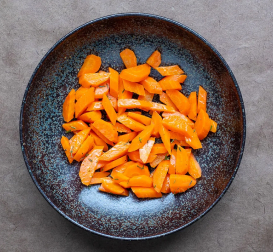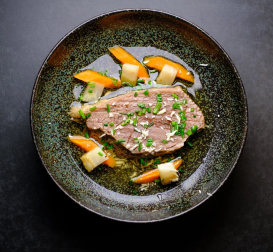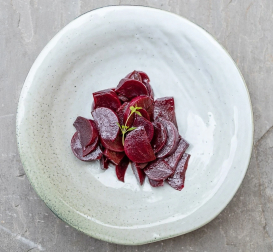Chicken Soup For A Cold Recipe

Author:
Thomas Sixt is a chef, food photographer, cookbook author and blogger.
Here he shares recipes, answers cooking questions and helps with cooking.
You can find my fine recipe for chicken soup for a cold in this post.
The soup is based on a newly interpreted TCM recipe and contains many spices and herbs to strengthen you.
TCM stands for Traditional Chinese Medicine.
Medicinal herbs and spices combined with a long cooking time create a particularly powerful chicken bouillon.
This broth has a strengthening and invigorating effect on colds and flu.
I wish you every success and, for once, a speedy recovery!
Table of Contents
1. Recipe Chicken Soup For A Cold
Below are the step-by-step instructions for your kitchen.
You can send me cooking questions using the comment function at the end of this page.
I look forward to exchange and feedback.
Chicken Soup For A Cold
Cooked, photographed and written down by chef Thomas Sixt.
Easy instructions for preparing chicken broth agains flu.

Ingredients
| 1 | Bunch | Soup vegetables |
| 1 | Piece | chicken |
| 1 | tsp | primal salt |
| 1/8 | Piece | cinnamon |
| 1 | tsp | majoram |
| 2 | pieces | anise |
| 1/2 | tsp | chili flakes |
| 1 | tsp | fennel (seed) |
| 3 | Pieces | Allspice Pimento |
| 7 | Pieces | juniper berries |
| 3 | Pieces | black pepper |
| 1 | tsp | Rosemary |
| 2 | tsp | mustard seeds |
| 1 | tsp | caraway seed |
| 300 | g | noodles |
| 1 | Bunch | chives |
Instruction

Prepare vegetables
Wash and prepare the soup vegetables.
Place the vegetables whole in the pot.

Prepare chicken
Trigger the chicken:
–> First cut the legs.
–> Detach the breasts along the sternum.
-> Then detach the legs and wings from the carcass.

Chop carcass
Chop the chicken carcass into small pieces.

Provide chicken
Place the chicken drumsticks, chicken breasts, chicken wings and chopped chicken carcass in the saucepan with the soup vegetables.

Prepare spices
Prepare the spices for the chicken soup according to the list of ingredients.

Provide ingredients
Place the spices and herbs in the pot with the remaining ingredients.

Add soup
Top up the soup ingredients with cold water.

Cook soup
Slowly bring the soup to a boil over low heat.
Let the soup simmer for 1.5 hours.
Remove the cooked chicken breasts.
Let the soup simmer gently for another 4-8 hours.
Add water to the soup if needed, keeping the ingredients in the saucepan covered with broth.

Taste soup
Season the soup with salt and pepper and enjoy.
Alternatively, leave to cool.

Cool soup
Let the soup cool completely.

Remove ingredients
Remove vegetables and meat.

Release meat
Discard the meat and return the bones to the broth.

Cook soup
Let the bones simmer gently for another 2-4-6 hours.

Prepare noodles
Prepare croissants or soup noodles.
Prepare a pot of boiling water and cook the soup noodles al dente according to package directions.

Provide noodles
Drain the al dente cooked pasta in a colander.

Prepare ingredients
Prepare fresh vegetables and cooked vegetables as well as meat and chives to add to the soup.

Prepare insert
Place raw vegetable soup garnish and meat in a saucepan.

Pass soup
Strain the ready-made soup into the prepared soup garnish.

Boil soup
Boil the soup and cook the raw vegetable fillings until soft.
Add the already cooked vegetables to warm them up.
Add the chives just before serving.

Arrange soup
Arrange the prepared soup noodles in deep soup plates.
Complete with soup and soup garnish.

Serve soup
Serve and enjoy the soup.
Bon appetit and get well soon.
Video
Cousine
Keyword
2. Nutrition Facts And Calories
3. Spices For Chicken Soup For A Cold
Primordial Salt
The preferred salt in my soup is unpurified crystal salt or Himalayan salt.
In contrast to purified salt, crystal salt contains more than 84 minerals and trace elements.
Today’s table salt consumption is considered harmful to health.
Our white table salt is chemically cleaned salt and therefore pure sodium chloride.
Essential minerals and trace elements, referred to as impurities, are extracted from the natural crystal salt.
Pure sodium chloride, i.e. table salt, puts a strain on the body and the excretory organs.
Crystal salt or Himalayan salt is used in natural medicine for brine drinking cures.
For more information, please visit the website of Dr. medical Barbara Henkel on the subject of salt applications .
In addition to the salt, I always use some tamari or soy sauce as a secret ingredient .
The seasoning sauce creates umami fireworks and makes the soup appear more powerful.
Cinnamon – Cylon Cinnamon
We like to enjoy the spicy-sweet-aromatic taste of ground cinnamon in rice pudding.
We often use cinnamon as a spice for Christmas dinner, for baking christmas cookies and as an ingredient in tea.
Cinnamon is used alongside anise as an ingredient in the preparation of a Vietnamese Pho Ga soup .
From a TCM perspective, cinnamon tonifies spleen yang and stomach yang.
Cinnamon helps with loss of appetite, it is said to relieve abdominal pain, reduce flatulence and help with diarrhea.
Cinnamon can relieve nausea, it is considered a top ingredient to overcome cold.
Marjoram
The pungent, somewhat bitter and aromatic tasting marjoram is used in a variety of ways in domestic cuisine.
We know the medicinal herb as an ingredient in fried potatoes , roast duck and roast goose .
Fresh and dried marjoram go well with roast lamb and braised beef.
From a TCM perspective, marjoram regulates qi and eliminates wind chill.
It calms the mind and dissolves cold, supports digestion.
The medicinal herb has a positive and strengthening effect on influenza infections.
Star Anise
We know the pungent and strong-tasting star anise as an ingredient in gingerbread spice .
Used in moderation, it gives venison dishes and soups a fine aroma of liquorice.
The anethole it contains is responsible for the liquorice aroma.
Star anise has a warmer and sweeter taste, and is therefore finer and more harmonious than the well-known liquorice taste.
Star anise also tastes good to people who don’t like liquorice.
From the point of view of TCM, star anise has a warming effect and dampness has a dissolving effect.
Star anise is considered a top ingredient for relieving coughs and bronchitis.
Chili
We use the hot chili pepper in the kitchen as a fresh and dried pod.
The dried and ground spice is called cayenne pepper.
The name Spanish pepper is less well known.
Chili gives soups and stews , meat dishes and pasta a subtle spiciness.
Spaghetti Aglio e Olio, for example, only develops its typical flavor when chili is added.
From a TCM perspective, chili regulates Qi and moves blood.
It eliminates wind and cold, has a tonic effect on Yang and is said to stop and regulate bleeding.
Chili is the top ingredient for colds, fever, rheumatic diseases and it even helps with potency problems 🙂
Fennel Seeds
Fennel seeds taste hot and aromatic, have an effect on the liver, kidneys and stomach.
We know fennel seeds as an ingredient in fennel tea, the vegetables as prepared as fennel vegetables and fennel salad.
In Mediterranean cuisine, fennel is used in bouillabaisse and for a wide variety of vegetable dishes.
From a TCM perspective, fennel seeds warm the center, regulate Qi and harmonize the stomach.
It warms the liver and kidneys and is said to relieve pain.
It increases appetite, relieves bloating, upset stomach, abdominal pain and bloating.
Used in the right amount, it adds a subtle flavor and harmoniously rounds off the soup.
Pimento
Pimenta officinalis has a hot taste and is also called new spice, clove pepper and Jamaica pepper.
It acts on the stomach, spleen and kidneys and is said to have a stomach-strengthening and metabolism-stimulating effect.
From the perspective of TCM, allspice has a warming effect and regulates Qi, helps with nausea and eliminates wind chill.
For the soup, I only add one to three whole grains so it doesn’t get too peppery.
Juniper
Juniiperus communis has an aromatic, sharply sour and sweet-bitter taste.
The fruit acts on the kidneys, bladder, spleen, stomach, intestines, lungs, liver and heart.
We know juniper in the kitchen as an addition to sauerkraut and game dishes.
Pheasant and roast venison harmonize perfectly with juniper, and the incense is also said to drive away evil spirits.
From the TCM point of view, juniper eliminates wind-cold, dissolves wetness and dampness, tonifies Qi, drains dampness, dampness and heat.
If you don’t like juniper, leave the berries whole or cook the berries in a tea strainer.
Peppercorns
The spicy-tasting pepper is one of the most important spices in our kitchen.
In the image below, chocolate pepper can be seen in its oblong shape.
Pepper has a digestive and stimulating effect.
From a TCM perspective, pepper has a warming effect.
It helps with stomach pain, indigestion and indigestion.
It is said to help with diarrhea and cold sensations and alleviate sore throats.
Finely ground pepper is hot and has a strong taste.
Added and cooked as a whole, it gives soups and sauces a fine aroma.
Rosemary
Rosmarinus officinalis is an aromatic, bitter-hot medicinal herb and spice.
Rosemary seasons meat dishes with beef and goes well with roast lamb.
Rosemary sprigs are a suitable brush for applying barbecue marinades when grilling .
Rosemary goes well with lemon.
The ingredients develop a special taste experience with the lemon chicken.
From the perspective of TCM, rosemary has a tonic effect on Qi and Yang, it eliminates cold and wind.
Rosemary is a secret ingredient for cold soup and helps with coughs and colds.
Mustard Seeds
We usually enjoy the spicy-tasting mustard seeds processed as mustard for bratwurst.
In TCM, mustard is described as regulating and moving Qi, warming and dissolving phlegm-cold.
Mustard seeds crushed with a mortar or mixed in the sauce develop a strong aroma.
A few grains cooked whole give soups and sauces a delicate taste.
Caraway seeds
Caraway is often found in bread, tastes good as a spice with fried potatoes, roast pork and soups.
Its taste is sharply sweet and reminiscent of anise.
In TCM, cumin is described as dissolving wetness and moisture.
It is said to strengthen the lungs and alleviate bronchitis.
More tips for adding medicinal herbs:
The well-known medicinal herb Mrs. Maria Treben describes yarrow tea and thyme syrup as an excellent remedy for relieving colds.
In any case, the addition of a little yarrow and thyme creates a fine taste in the soup.
The thyme aroma is more familiar to us than sharpening, it tastes a bit bitter and here less is more.
Overview of the spices and herbs used:

4. Tips For Chicken Broth When You Have A Cold
The soup is made by the long cooking time and the addition of herbs and spices to the chicken soup according to TCM.
You can also start the preparation without meat and just cook the bones with the vegetables and spices for a long time.
In the recipe I do it the other way around.
I set up all the ingredients, take out the chicken drumsticks and chicken breasts when they are cooked.
This way you can detach the chicken thighs and wings, prepare the meat and put the bones back into the soup.
Sometimes I cook a chicken thigh or even two and wait for them to fall apart.
The soup becomes even stronger in taste and effect.
A cooking time of 3.5 hours is suggested as early as 1914 for chicken soup in Mary Hahn’s cookbook.
In terms of a long cooking time according to TCM, 4-12 hours is a good guideline.
The bones release flavor and collagen protein for about 7-9 hours, which dissolves in the broth.
Cooking here means gently simmering. The ingredients in the pot should always be well covered with liquid.
You can simply fill up with cold water and let the soup continue to boil.
When you have a cold, you often lack the strength for long cooking magic.
You can also prepare the soup, let it boil and take out the soup.
I often take the soup off the stove in the evening and let it cool down.
To cool the soup, place a ladle in the soup and leave the lid slightly open.
This allows the heat to escape. The next day I continue to cook the soup and take out the desired amount as needed.
My ingredients are easy to come by and a twist on the soup.
Common ingredients that are also used for a TCM soup are:
Common ingredients:
Ginger
Bay leaf
Galangal
Mace flower
Parsley
Exotic ingredients:
Goji berries / Wolfberry
Chinese dates / Chinese jujube
Huang Qui
Chinese angelica
Lotus Nuts /Lotus Seeds
My grandmother from Bavaria often cooked chicken soup during the flu season and when she had a cold.
At that time there were no exotic ingredients and all the spices and ingredients described went into the pot.
In addition, she added the herbal tea she collected herself, lots of lovage and parsley to the soup.
The soup always helped and at least felt that it relieved and drove away the flu and cold.
Did you know?
Vitamin C tip from chef Thomas Sixt
Fresh parsley contains more vitamin C than lemon.
The citrus fruit contains 50 milligrams
vitamin C per 100 g,
Parsley contains 160 milligrams of vitamin C per 100 g.
Use fresh parsley and let it simmer briefly in the hot soup.


5. More Ideas For Soup

Chervil Soup

Red Lentil Soup Recipe

Impressive Squash Soup Recipe

Prepare Fish Soup with Salmon Head

Green Asparagus Soup

Bean Soup

Parsnip Soup Recipe

Mushroom Soup Recipe with Muffin Bread

Eel Soup Recipe, German Fish Soup with all inclusive

Kale Soup Vegetarian Recipe

Kale Soup with Eel Recipe for a perfect Dinner

Black Salsify Soup Recipe

Asparagus Soup with Salmon Recipe

Asparagus Soup with Coconut Milk Recipe

Asparagus Cream Soup Recipe

Asparagus Soup Recipe

Wild Garlic Soup Recipe with Fish and Vegetables

Potato Soup with Shrimps, an original North German Soup with North Sea Crabs

Cold Cucumber Soup Recipe with Salmon Tartare or Avocado Tartare

Kohlrabi Soup Recipe

Potato Soup Recipe with +10 Variation Tips

Borscht Recipe Newly Interpreted

Beetroot Soup Recipe

Pea Soup Recipe with Top Chef Tips
Comments, Cooking Questions and Answers
Below you can write to me directly.
Please don’t forget the star rating on the recipe, 5 stars means you liked it!





